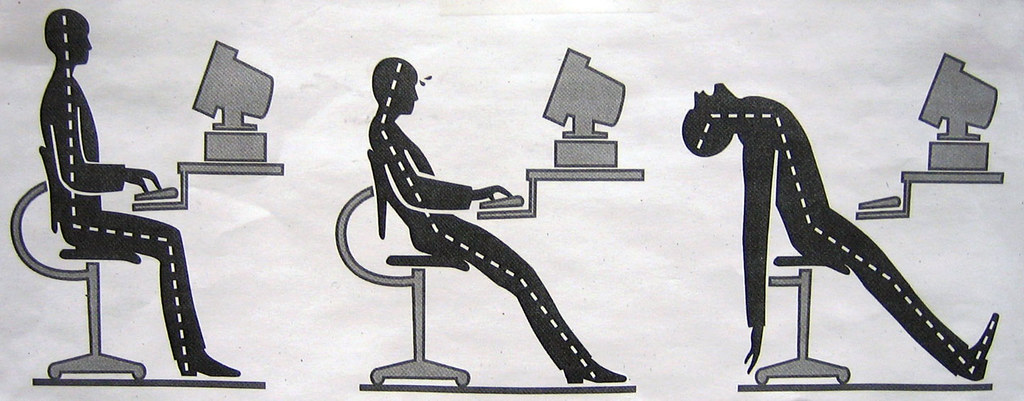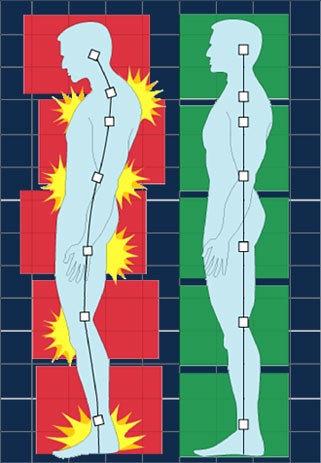The good news is that, if you do struggle with bad posture, you might be able to improve your COPD symptoms simply by changing how you position your body. By paying attention to how you sleep, sit, stand, and lie down, you can make adjustments that reduce the strain on your lungs and muscles and make it easier to breathe.
How Posture Affects COPD

Some of the main symptoms of COPD include reduced lung function, chest discomfort, shortness of breath, and difficulty breathing. Because of this, the lungs of people with COPD need all the help they can get to function efficiently and take in enough oxygen.
However, when you assume a hunched posture, it compresses your chest cavity and pushes your rib cage against your lungs and diaphragm. This constricts your diaphragm and makes it more difficult for your lungs to expand.
As a result, you take shallower breaths and get less oxygen when you slouch than you do when you stand or sit up straight.
In this way, poor posture can cause chest discomfort and breathlessness that can make it very difficult and uncomfortable to breathe. Getting into the habit of hunching forward for significant periods of time can significantly affect your respiration and lower your blood oxygen levels, which can be dangerous day after day.
You can see the difference for yourself by comparing how comfortably you can breathe in an upright versus hunched over position.
First, sit and lean forward with your shoulders drooped forward and your neck bent toward your chest. Try to take a few deep breaths. You should notice that your chest feels compressed and your breaths feel restricted.

Next, sit up straight. Hold your chin up parallel to the ground and put your shoulders back, so your back is straight and your shoulders are parallel with your hips. Now, try to take a few deep breaths again. Do you notice that your chest feels more open, and it's much easier to breathe?
If you did this right, the difference should be obvious; a poor, hunched posture puts a great deal of strain on your ability to breathe, while an upright posture takes off the pressure and makes it much easier for your lungs to expand. This difference is apparent after only a few moments of holding a hunched posture, so you can imagine how much strain it puts on your lungs if you have bad posture all the time.
Even though it's clear that body posture can have a significant effect on COPD symptoms, some doctors are beginning to believe that it can go the other way, too. They think that simply having COPD can directly affect your posture and can lead people with the disease to develop negative postural habits.
How COPD Affects Your Posture

If you have COPD, take a moment to think about what you do when you have difficulty breathing. Do you tilt your body forward when you try to catch your breath?
Whether or not this is your reaction to breathlessness, many doctors have noticed that this is a common posture people with COPD assume when they have difficulty breathing. They believe that, in the short term, this forward-leaning position might help relieve the feeling of breathlessness.
This is a learned posture that many people with respiratory illnesses get in the habit of doing. In the short term, this can be helpful and make it easier to breathe when you're having trouble.
However, if you do this often, it's important to tilt your body forward while keeping your back straight and your shoulders relaxed. You could end up putting even more strain on your lungs and the rest of your body if you aren't careful.
The Effects of Bad Posture

Bad posture hurts more than just your breathing. It can cause stiffness, pain, and other complications elsewhere in your body that can affect your ability to exercise and do daily activities.
When your body is not aligned the way it was designed to be, it forces other muscles and joints to have to take over. These muscles aren't designed to hold up your body's weight, and they become sore and strained when you don't practice good posture.
Here are some of the major effects that bad posture can have on your body:
- Shoulder, Neck, and Back Pain: Slouching forward can put enormous strain on the muscles in your neck, back, and shoulders. This results in soreness, stiffness, and joint damage, and over time can cause permanent disfigurement.
- Jaw and Head Pain: Bending your neck forward often, as many people do when working at a desk or computer, can strain the muscles, tendons, and joints in your neck and jaw. It can cause muscle tightness that radiates to the head, which leads to jaw tension and headaches.
- Gastrointestinal Pain: Hunching forward puts pressure on your stomach and intestines, making it harder for them to function and move food through your digestive system. This can lead to stomachaches, pain, and indigestion.
- Reduced Lung Function: As we discussed before, hunching forward puts pressure on your lungs and reduces their capacity by up to thirty percent. This makes it difficult for your lungs to get enough oxygen, which can be especially troublesome for people with respiratory conditions who already have reduced lung function.
- Reshaping Bones and Joints: Extra pressure on certain bones and joints that aren't suited for the role can actually cause them to change shape. Certain muscles and tendons get shorter or longer over time due to improper posture that positions your body unnaturally. This can lead to stiffness, soreness, decreased mobility, and, in the worst cases, a permanently hunched-over posture.
|
|
| Image courtesy of Aidan Jones on Flickr. |
The strain that bad posture puts on your muscles, organs, and joints only makes it more difficult to move and exercise. And the more your physical activity is limited, the more likely you are to experience worsened COPD symptoms and quicker disease progression.
Since living with COPD already weakens your muscles and makes physical activity difficult, the last thing you need is to be even further hindered by the effects of bad posture.
What Good Posture Looks Like

In general, good posture is a straight posture. Your back should form a straight line connecting your hips, shoulders and head.
That means no slouching or bending for extended periods of time. Pay attention to your normal posture and look out for habits like leaning back, hunching forward, and pulling your shoulders or neck toward your chest
Here's a list of bad postural habits to watch out for:
- Shifting your weight to one foot or the other, which puts extra strain on your hips and spine. You should try to distribute your weight evenly between both feet instead.
- Bending forward over your phone, laptop, or desk. This strains your neck, back, and shoulders and reduces your flexibility.
- Using your shoulder to prop your phone against your ear puts strain on your shoulders, neck, and upper back. Hold your phone in your hand or use a hands-free device like a bluetooth earpiece, instead.
- Bending your neck back and your chin up in order to look up at a screen. Make sure your screen is positioned in such a way that you can keep your back and neck straight while viewing it.
- Standing with your pelvis pushed back and your chest pushed forward, a position that exaggerates the curve in your lower back.
- Standing with your back flat, which forces you to pull your pelvis forward and hunch slightly. In a proper posture, your spine should have three curves: it curves in at your lower back, out at your chest, and back in again at your neck.
It can be hard to break bad posture habits like these because, over time, they start to feel natural and comfortable. You have to be diligent about catching yourself slouching or practicing bad posture, and make an effort to correct it every time to successfully break the habit.
Over time, you can train yourself to hold a better posture that will help your muscles, joints, and lungs stay healthy. In fact, there is a wide variety of benefits that you can gain if you dedicate yourself to practicing good posture.
Here are some of the greatest benefits you can gain from good posture:
- Prevent muscle strain and soreness in your back, neck, shoulders, and limbs
- Reduce strain on joints and ligaments throughout your body, especially your spine.
- Prevent bone and spine stiffness and disfigurement
- Increase the efficiency of your muscles, which increases physical endurance and reduces fatigue
- Prevent abnormal wear and tear on your joint surfaces
- Reduce your risk of arthritis
- Improve your confidence and physical appearance
How to Practice Good Sitting Posture

Poor sitting posture is extremely common. And now that most people in the developed world do at least 75% of their work sitting down, learning proper sitting posture is more important for health than ever before.
A hunched posture while sitting is one of the worst positions for someone with COPD because it constricts your chest and makes your lungs have to work extra hard to breathe. If you stay in a hunched position for prolonged periods of time, it can even reduce your blood oxygen saturation and contribute to hypoxia.
Good sitting posture, however, opens up your chest and takes pressure off of your lungs and diaphragm. You should keep your back as straight as possible (while maintaining the curvature of your spine) and keep your neck and shoulders aligned with your hips. Any bending or leaning forward or backward should happen at your waist, not your chest or back.
It's okay to tilt your chest forward if needed, as long as you keep your back straight and refrain from tensing your neck and shoulders. In fact, research shows that leaning forward slightly while sitting or standing can actually make it easier for people with respiratory conditions to breathe.
Here are some general guidelines for proper sitting posture:
- Keep your back straight at all times and your feet flat on the floor.
- Your back should always have three curves: at your lower back (lumbar curve), chest (thoracic curve), and neck (cervical curve). Your spine, when viewed from the side, should look roughly like an elongated “S” shape.
- Your knees should form a right angle (approximately) when you sit.
- Scoot all the way back into your seat when you sit down. In general, the back of your buttocks should be touching the back of your chair when you sit.
- Always keep your weight evenly distributed between both hips so you don't put extra pressure and strain on one side.
- Use a chair with back support when possible. If you are sitting in a straight-backed chair, you can place a rolled-up towel between the chair and your lower back to support the natural curve of your spine.
- Don't sit still in one place for more than thirty minutes at a time. Take breaks to stand, stretch, and move around whenever possible.
- Use an office chair with a seat that can spin, that way you can turn the whole chair when you need to turn left or right. This helps you keep your back straight instead of twisting at your waist all the time.

It's easy to get in the habit of hunching your body forward, and sitting upright probably won't feel right at first. But if you put forth a conscious effort to practice proper sitting posture, it will start to feel much more natural and more comfortable with time.
Here is an example of a good sitting posture you can use to breathe better with COPD:
- Keep both feet flat on the floor at all times to keep your hips and back supported.
- Keeping your back straight, lean forward slightly and rest your elbows on your knees. You may also rest your elbows on a table or flat surface in front of you.
- If you need extra support, you can rest your chin in the palms of your hands.
- Make sure your neck and shoulders are relaxed. Do not tense them or allow them to slump forward.
How to Practice Good Standing Posture

Even if you spend most of your day sitting down, it's important to pay attention to your posture when you stand, too. If you develop the habit of using correct, upright standing posture you can increase your standing endurance, breathe easier, and reduce muscle soreness and fatigue.
Here are some general guidelines for proper standing posture:
- Keep your shoulders back, relaxed, and aligned with your hips.
- Keep your chin up and parallel to the ground. Don't lean forward or bend your neck forward when standing or walking.
- Bend your knees slightly and keep your feet about shoulder's-width apart.
- Tuck your stomach in and keep your back straight; don't lean back or push your hips forward when standing.
- Wear comfortable shoes with good arch and ankle support.
- Don't stand still for long periods of time. Move around, walk, stretch, and shift your weight to prevent soreness and strain.
 |
| Image courtesy of Beth Scupham on Flickr. |
Here are two examples of proper standing positions you can practice to improve your posture.
Standing Posture 1:
- Stand with your feet spread about shoulder's width apart.
- Make sure your weight is distributed evenly between both feet, so you're not leaning on one leg or another.
- Lean your hips back against a wall for support if needed and rest your hands on your thighs.
- Keep your shoulders relaxed and parallel with your waist.
- You can lean forward slightly and let your arms hang in front of you as well.
Standing Posture 2:
- Stand with your feet spread about shoulder's width apart.
- Make sure your weight is distributed evenly between both feet, so you're not leaning on one leg or another.
- Rest your hands or arms on a chair, table, or another piece of furniture in front of you that's below shoulder height.
- Rest your head on your hands or forearms if needed.
How to Practice Good Sleeping Posture
|
|
| Image courtesy of Esther Max on Flickr. |
Many people don't think about how they position themselves when they sleep, but bad sleeping posture can significantly affect your body. Most people spend 6-9 hours every night in bed, and how you position your body during that time can significantly affect your muscles and your ability to breathe.
Here are some general tips for good posture while you sleep:
- Choose a mattress that is medium firmness. You want it to be soft, yet not so soft that it doesn't support the curves of your body.
- Use a lumbar support for your lower back if needed.
- As always, it's important to keep the natural curvature of your spine intact. Here's how you can do this while you sleep.
- If you sleep on your back, put a pillow or rolled towel under your knees. You can also place a lumbar support roll under your lower back.
- If you sleep on your side, bend your knees slightly at the knee. Don't pull your knees up toward your chest.
- Avoid sleeping on your stomach, which can strain your back and neck.
Here are two examples of good sleeping positions you can practice for better posture:
Proper Sleeping Posture 1:
- Sleep on your back and put a pillow under your head to support your head and neck.
- Bend your knees slightly and place a pillow or rolled-up towel under your knees. This will help keep your spine straight and relieve pressure on your lower back.
Proper Sleeping Posture 2:
- Sleep on your side with your knees slightly bent, but not pulled up toward your chest.
- Put a pillow under your head to keep your head elevated and your neck supported.
- Tuck a pillow in-between your knees.
- Do your best to keep your back straight while you sleep. Don't curl up your body or tuck your chin in.
Improving Flexibility

Unnatural postures causes stiffness and a variety of imbalances in your muscles, tendons, and joints. If you have had bad posture for a long time, chances are your body needs some work to restore natural balance and flexibility.
Regular exercise and physical activity is one of the best ways to restore strength and flexibility to your muscles and joints, but it's important to take time to stretch as well. There are a variety of simple stretching exercises you can do at home and before workouts that can help you improve your posture and flexibility.
Here are some stretching exercises you can do to support better posture:
- Chin tucks (Neck Flexion): Sit or stand up straight and tilt your neck down toward your chest and hold. Follow up this stretch with neck extensions
. - Neck extensions: Sit or stand up straight, tilt your head straight back, and hold. Keep your shoulders as relaxed as possible.
- Chin retractions: Sit or stand up straight and push your chin forward. Then pull your chin back and tuck it in slightly—but not too much—keeping it parallel to the floor. Hold for a moment and repeat.

Shoulders
- Shoulder rolls: Sit or stand with your back straight and roll your shoulders backward. Start by pulling your shoulders up (like a shrug) and then pushing them backward, down, then forward again. Repeat ten times, then reverse the direction by rolling your shoulders forward another ten times.
- Arm stretch: Straighten your right arm and cross it over your chest. Place your left hand on your upper-left arm to hold it in place and pull it closer to your chest. Hold, then repeat with your left arm.
- Upper back stretch: Sit up straight and clasp your hands together in front of you with your fingers interlaced. Then, turn your palms facing away from your body and push out, extending your arms all the way, and hold.
- Lower back stretch: Lie on your back on a flat, firm surface. Bend your knees slightly and place both feet flat on the floor. Reach up with both hands and grasp your thigh behind one knee. Pull your knee in toward your chest until you feel the stretch in your lower back and hold. Then, lower your foot back to the ground and repeat with your other leg.
Chest
- Open chest stretch: Stand with your side facing a wall or doorway. Extend one arm and place it on the wall or doorframe, then twist at the waist, turning your body away from the wall. Twist until you feel the stretch in your chest and shoulder and hold. Next, turn so that your other side faces the wall or doorframe and repeat with your other arm.

You can do most of these stretching exercises while sitting in a chair to save energy. You should hold each stretch for about 20-30 seconds at a time (unless otherwise indicated) and repeat 2-3 times.
If you still find it difficult to perform light exercises like these, talk to your doctor. You might need to take physical therapy or a pulmonary rehabilitation class to help you get into good enough shape to exercise on your own.
Conclusion
Managing breathlessness and difficulty breathing is one of the most important skills you can learn if you have COPD. Learning to have better posture is an effective and simple means to better control your symptoms.
By practicing a straighter, more natural posture, your body will be in a better position to breathe without extra pressure or strain. Not only that, but good posture will also reduce aches, pains, and cramps in the rest of your body.
But just as important as knowing good posture is knowing what positions to avoid. Breaking negative postural habits can be tricky, but with enough attention and diligence you can get to the point that you use good posture without even having to think about it.
It can be difficult to get in the habit of sitting, sleeping, and standing in the right way, but you get to reap the benefits of feeling better, breathing better, and better mobility. Once you practice the postures on this list for awhile, you will have no desire to return to your old, stiff, slouching ways.


.png)





